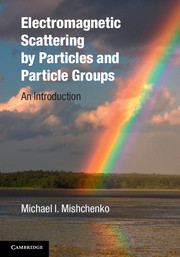Book contents
- Frontmatter
- Dedication
- Contents
- Preface
- Acknowledgments
- Acronyms
- 1 Introduction
- 2 The macroscopic Maxwell equations and monochromatic fields
- 3 Fundamental homogeneous-medium solutions of the macroscopic Maxwell equations
- 4 Basic theory of frequency-domain electromagnetic scattering by a fixed finite object
- 5 Far-field scattering
- 6 The Foldy equations
- 7 The Stokes parameters
- 8 Poynting–Stokes tensor
- 9 Polychromatic electromagnetic fields
- 10 Polychromatic scattering by fixed and randomly changing objects
- 11 Measurement of electromagnetic energy flow
- 12 Measurement of the Stokes parameters
- 13 Description of far-field scattering in terms of actual optical observables
- 14 Electromagnetic scattering by a small random group of sparsely distributed particles
- 15 Statistically isotropic and mirror-symmetric random particles
- 16 Numerical computations and laboratory measurements of electromagnetic scattering
- 17 Far-field observables: qualitative and quantitative traits
- 18 Electromagnetic scattering by discrete random media: far field
- 19 Near-field scattering by a sparse discrete random medium: microphysical radiative transfer theory
- 20 Radiative transfer in plane-parallel particulate media
- 21 Weak localization
- 22 Epilogue
- Appendix A Dyads and dyadics
- Appendix B Free-space dyadic Green's function
- Appendix C Euler rotation angles
- Appendix D Spherical-wave decomposition of a plane wave in the far zone
- Appendix E Integration quadrature formulas
- Appendix F Wigner d-functions
- Appendix G Stationary phase evaluation of a double integral
- Appendix H Hints and answers to selected problems
- References
- Index
- Plate Section
1 - Introduction
Published online by Cambridge University Press: 05 July 2014
- Frontmatter
- Dedication
- Contents
- Preface
- Acknowledgments
- Acronyms
- 1 Introduction
- 2 The macroscopic Maxwell equations and monochromatic fields
- 3 Fundamental homogeneous-medium solutions of the macroscopic Maxwell equations
- 4 Basic theory of frequency-domain electromagnetic scattering by a fixed finite object
- 5 Far-field scattering
- 6 The Foldy equations
- 7 The Stokes parameters
- 8 Poynting–Stokes tensor
- 9 Polychromatic electromagnetic fields
- 10 Polychromatic scattering by fixed and randomly changing objects
- 11 Measurement of electromagnetic energy flow
- 12 Measurement of the Stokes parameters
- 13 Description of far-field scattering in terms of actual optical observables
- 14 Electromagnetic scattering by a small random group of sparsely distributed particles
- 15 Statistically isotropic and mirror-symmetric random particles
- 16 Numerical computations and laboratory measurements of electromagnetic scattering
- 17 Far-field observables: qualitative and quantitative traits
- 18 Electromagnetic scattering by discrete random media: far field
- 19 Near-field scattering by a sparse discrete random medium: microphysical radiative transfer theory
- 20 Radiative transfer in plane-parallel particulate media
- 21 Weak localization
- 22 Epilogue
- Appendix A Dyads and dyadics
- Appendix B Free-space dyadic Green's function
- Appendix C Euler rotation angles
- Appendix D Spherical-wave decomposition of a plane wave in the far zone
- Appendix E Integration quadrature formulas
- Appendix F Wigner d-functions
- Appendix G Stationary phase evaluation of a double integral
- Appendix H Hints and answers to selected problems
- References
- Index
- Plate Section
Summary
Electromagnetic scattering by an isolated particle or a multi-particle group is a ubiquitous phenomenon central to a wide variety of science and engineering disciplines. Field—matter interactions described by macroscopic electromagnetics typically occur in a natural way. They can affect accompanying physical and chemical processes as well as the very state of the scattering object and often yield an electromagnetic signal that can be measured and analyzed with the purpose of retrieving useful information about the object. Electromagnetic scattering can also be induced artificially and used as an active means of in situ or remote diagnostics of certain physical properties of the particle(s). In order to interpret laboratory, field, and remote-sensing measurements of electromagnetic scattering by various single- and multi-particle objects, one needs a deep understanding of this phenomenon, as well as the ability to predict quantitatively its various manifestations as functions of the physical parameters of the objects.
The diversity of sizes, morphologies, and refractive indices of particles encountered in natural and artificial environments is virtually limitless, as illustrated by Fig. 1.1. This factor complicates accurate quantitative modeling of electromagnetic scattering and absorption, even by solitary particles such as those suspended individually in the trap volume of an electrostatic (as shown in Plate 1.1a) or optical levitator. The task of optical modeling of a large group of sparsely distributed particles such as a cloud (see, e.g., Plates 1.1b and 1.1c) is significantly more involved.
Information
- Type
- Chapter
- Information
- Electromagnetic Scattering by Particles and Particle GroupsAn Introduction, pp. 1 - 14Publisher: Cambridge University PressPrint publication year: 2014
Accessibility standard: Unknown
Why this information is here
This section outlines the accessibility features of this content - including support for screen readers, full keyboard navigation and high-contrast display options. This may not be relevant for you.Accessibility Information
- 1
- Cited by
